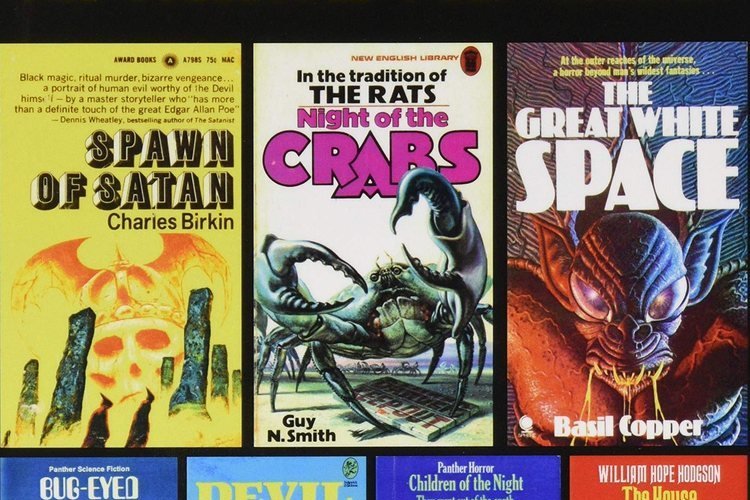THE COLLECTED PULP HORROR, VOL. 1: Diving Deeply Into Antiquarian Chills
Despite its generally frowned-upon reputation, thehorror genre has a rich history in the publishing world. Ever since the idea ofcheaply published fiction came into being, spooky stories have been one itsstaples. Its commercial fortunes may wax and wane but the fun of gettingcreeped out by eerieness on the printed page has proven itself to be timeless -and there are stacks upon stacks of pulp horror magazines and paperbacks toprove the point.
Delving into such a densely-populated world can bedaunting for newcomers but the good news is vintage pulp horror has a healthycrop of fans, all eager to share their knowledge and recommendations. Forexample, consider The Collected PulpHorror, Vol. 1. This collects material from the first three issues of Pulp Horror, one of several vintage-printenthusiast 'zines published by the prolific Justin Marriott. In the articles collected in this reprint, youget to explore an interesting cross-section of topics that illustrate the manyflavors of experience in the pulp horror world.
In a move that might be controversial with some readers,The Collected Pulp Horror, Vol. 1 doesnot contain the full contents of all three issues it covers. Marriott haspruned a few interviews from the third issue and done some additional editingon other pieces. If that offends thesensibilities of hardcore collector types, it's worth mentioning that he also addedthree bonus interviews from his archives to flesh the package that make a prettydecent tradeoff for the aforementioned edits.

The material from the first issue focuses mainly on featurereviews of different books: subjects include Dagon by Fred Chappell, a famous Cthulhu Mythos homage that mixesin modern levels of sexuality and masochism, and Ritual, a novel by that is considered by David Pinner that isconsidered to be the uncredited inspiration for the film The Wicker Man. You also get a few magazine-themed pieces: there'san in-depth look at Strange Tales, acompetitor to the more famous WeirdTales and Vampire Horror Roman,a long-running German horror fiction magazine.
The bonus inclusion in this section is a 2003 interviewwith Michel Parry, an editor famous to European horror fans for his work in creatinganthologies of the genre. His story isan epic tale that also includes everything from pioneering work in the 'zinefield to a brief stint working for American International Pictures. It's the stuff of horror fanboy dreams cometrue and lifelong fans of the genre are likely to find it charming.
The second issue was built around a theme of sciencefiction in horror and offers the best material of the collection inSchlockmania's estimation. There are some fantastic retrospective pieces here:there's an article that explores science fiction short stories and novels witha strong horrific bent that covers everything from "Who Goes There"to Joe R. Lansdale's The Drive-Inand a nifty piece exploring how A.E. Van Vogt's invention the "bug eyed monster"subgenre had a big ripple effect through sci-fi writing, comics and films. Youalso get in-depth looks at cult novels like The Puppet Masters and DamnationAlley that blend an appreciation for their importance with a clear-eyedassessment of their flaws and quirks.
The bonus interview for this section is a chat with GuyN. Smith and it's a delight. Smith is infamous in horror circles for hisquickly written and gleefully trashy paperback originals, most notably hispopular series of Killer Crabsnovels, and he discusses his history in an unpretentious, sometimes raffishlyfunny manner. His recollections vividlydepict an era when a pulp writer capable of banging out prose by the poundcould make a solid middle class living at it.
The material from issue three was also built around atheme: in this case, it was devoted to genre reissue publisher ValancourtBooks. Books covered here include TheGodsend, a "killer kid" novel from Bernard Taylor with a subtlychilling approach, and Cold Moon OverBabylon, a novel from Michael McDowell that mixes Southern Gothic withhorror. Elsewhere, you get interestingauthor overview pieces on John Blackburn, a writer who blended horror andsci-fi themes with experimental adventurousness and Charles Birkin, aspecialist in short stories with a cruel edge whose work still divides readers.
The bonus interview in this section is with Robert Lory,an author famous with paperback horror fans for his work on the Dracula and Horrorscope series published by Pinnacle Books. He looks back onhis time in the pulp mines with a cheerfully bent sense of humor.
To sum up, TheCollected Pulp Horror, Vol. 1 is a solid deal for fans of horror in printform. The writing is consistently sharp and insightful, the interviews are allentertaining and the cost-effective package delivers 130 pages of reading forjust seven bucks at Amazon. Like the pulps that inspired its contents, thisdelivers plentiful bang for your bucks.


